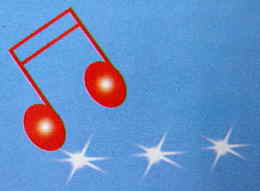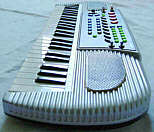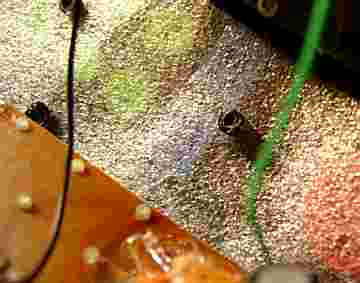
Is this an essential equipment item on board of every JU-52 aeroplane and zeppelin?!?

 |
(noble
My
Music Center variant with 49 keys, accompaniment & many Asian/
Oriental demos)
Hmm... ;-)
Is this an essential equipment item on board of every JU-52 aeroplane and zeppelin?!? |
 |
Despite this midsize keyboard has a noble silver case design in a wonderful retro style, it unfortunately is one of the worst tablehooters, because (at least in unmodified state) nasty design flaws prevent reliable polyphonic play. Also many of the product features claimed on its German box and manual are (fraudulently?) false.
 |
 |
On the control panel stands "SANKAI-01870K" and "Elektronisches Keyboard mit 49 Tasten" ("electronic keyboard with 49 keys"). According to photos in the German manual, this instrument was also released as Miles MLS-490B. The Miles brand seems to be identical with Yongmei, the manufacturer of the likely worst keyboards of the world (see here). Very annoying is that in unmodified state only monophonic play is reliable possible because many key combinations don't work because the manufacturer omitted the key matrix diodes to save a few cents.
Generally there are many other things severely wrong with this tablehooter.
There are not only a few Engrish misspellings on it, but the instrument
has way less features like claimed on its German language box. Most blatant
is that there are only 8 instead of the claimed 10 preset rhythms, and
also other claimed features exist not at all, or only deeply buried inside
the CPU as keyboard matrix eastereggs. The box claims:
| original German box text: | translated into English: | comment: |
| 49 Standard Tasten | 49 standard keys | Keys are not "standard" (= fullsize) but midsize. |
| 12Timbres/ 10 Rhythmus/ 8 Percussion instrumente | 12timbres/ 10 rhythms/ 8 percussion instruments | Only 8 rhythm and 4 percussion instruments (on drumpads) exist on the instrument. (But 10 rhythms and 8 drumpads are supported by the CPU as key matrix eastereggs.) |
| Bass Akkorde automatisch/ per Einzelauswahl oder durch Mehrfingertechnik | bass chords automatic/ by single finger or fingered chord technique | Fingered chord mode does not exist. |
| Akkord/ Tremolo/ Portamento/ Infix/ Bass Effect | chord/ tremolo/ portamento/ infix/ bass effect | There are no such effect controls. Especially the portamento (glide tones) exists not at all (not even as part of the demos) on this instrument. It is also a mystery what "infix" shall be. |
| 20 gespeicherte Demo Musikstücke | 20 stored demo musics | only 16 are playable (4 are matrix eastereggs). |
| 25 Level für Rhythmustempo/ 8 Level für Lautstärke einstellbar | 25 levels for rhythm tempo, 8 level for volume adjustable | Volume control has 16, rhythm tempo 22 steps instead. |
I am not sure if these false claims were made to fraud customers, or
if the feature list on the box was simply copied from a predecessor or
prototype version which indeed matched these specifications. Strange is
that the B/W instrument photos in the manual have a "Miles" logo that was
covered (by hand?) with "Sankai" and "01870K" stickers. Like with the infamous
Yongmei
tablehooters (see here), the AC adapter
jack is wired parallel(!) to the battery compartment, thus any attempts
to use it with batteries inserted may cause the batteries to EXPLODE (and
also the microphone would certainly not survive to be accidentally plugged
in here instead of the identical "MIC" jack next to it). Therefore this
Chinese thing contradicts the "CE" rules and thus would be theoretically
illegal to import into the EU (and certainly USA too). The German importer
of this questionable plastic bomb is indicated on the box as:
| Hergestellt für [manufactured for]
Haltermann & Schulte
|
Fortunately at least with some (fairly time consuming) modifications this tablehooter can be converted into a reliable working instrument. Very unusual is that the back of the manual shows a tiny (badly readable) copy of the schematics, which shows a different (and flawless!) template implementation of this hardware, which has a stereo amplifier and shows a key matrix with diodes and all (but one) keyboard matrix eastereggs.

|
polarity protection diodes added. sound output jacks with speaker mute switch added. wrong speaker polarity corrected. keyboard & drumpads upgraded with matrix diodes. redundant demo "SEL" button rewired for 3rd demo bank. buttons for 2 additional preset rhythms + 4 additional drumpads added. drumpads rewired to match icons. upgraded to stereo: 2nd power amplifier with volume potentiometer added. case de-rumbled by various measures.
Possibly the Sankai 01870K has one of the first Sankai CPUs, because although its 49 keys, crystal clocked hardware and accompaniment patterns already correspond to my other Sankai (sound bank) instruments, the preset sounds and OBS controls are still much like My Music Center. Like the latter, all preset sounds are made from each a static waveform and include a cold and glassy, detuned lo-fi chorus and some sustain (thus no very short notes can be played). But unlike the latter, the quite linear (unrealistic) volume envelopes have only little zipper noise, the aliasing noise of high notes is less extreme, and like with Feng Yuan 28061 the tremolo speed of the chorus varies much with the note pitch (the higher, the faster). All preset sounds start in a medium high octave range, thus no really low bass notes can be played despite 49 keys. The "piano" sounds rather honky- tonk- like; "guitar" is same but a bit harsher. Also the "harp" is similar but shorter, and "banjo" is even harsher and shorter (timbre is fairly realistic). The "bell" resembles a vibraphone, while "music box" is the same in duller (fairly realistic). The "organ" attempts to be a metal pipe organ rank. The "violin" is harsh and resembles more an accordion; "trumpet" is the same in duller and a bit more sonorous, "string" is even duller. Also "flute" is even duller and reminds to a human chorus. The "saxophone" otherwise is a very harsh harmonica timbre (about like the My Music Center "trumpet"). The "suatain" button prolongs the sustain phase instead of the release phase, and thus simply behaves like holding the key longer down for 0.5s instead of adding a real sustain. The vibrato ("VIB" button) is a highlight of this instrument; it sounds quite unique since it adds to the timbre a grainy (but not very strong) zipper noise texture that reminds rather a small dose of fast mandolin ring than a normal vibrato. Likely this effect modulates only one of the 2 suboscillators the chorus is made of, but unlike other My Music Center variants it does not disable the chorus, thus the tremolo of it is still present and only gets an additional texture (similar like the gritty 4 operator FM "ensemble" presets on Fujitone 6A or Yamaha PSS-390), which also makes the timbres a bit warmer and more harmonic.
The percussion of this instrument is made from low resolution samples, but sounds different and a bit better (less thin and noisy) than on My Music Center. The 8 OBS rhythms sound more generic than on the Sankai 01504H or K-Mark, since they employ no latin percussion but only base, snare and closed cymbal. All OBS rhythm preset buttons immediately (re-)start their rhythm, but also select a default tempo for each rhythm, which limits their use as a realtime sound control. The default tempo varies much among rhythms ("waltz" is very slow). The "fill-in" button always waits until the end of the current rhythm pattern before it inserts the fill-in pattern, and it also behaves a bit unpredictable, which limits its use a lot. With the "stop" button any rhythms or other sounds can be stopped immediately, which makes also a good realtime effect.
The single finger accompaniment knows only 3(?) chords. The accompaniment consists of e-bass and usually sweetish e-piano chords, and the styles are quite over- orchestrated and thus less versatile. Most styles contain a sweetish pop arpeggio and remind to Casio SK-1 accompaniments. By the limited choice of chords they can never sound nasty or disharmonic and also react a bit slow on chord changes. There is no manual chord mode (without rhythm). Strange is that the accompaniment section reaches to the 18. key of the keyboard (2nd octave "F") while the letters above the keys suggest it to end already on the first "B" (which would be more reasonable since there is no fingered chord mode). Confusing is that the "chord" button behaves like a synchro start feature and waits to the end of the current rhythm pattern before starting or stopping the accompaniment. Unlike the main volume control, the accompaniment volume control ("A.B.C. volume") very badly reduces the bit resolution of rhythms and accompaniment notes, which truncates their decay envelopes the earlier, the lower the volume is set. But this I consider rather a sound effect than a flaw.
Like the Letron MC-3 (see there) and many similar instruments, also the Sankai 01870K has a programmable (monophonic) drum pattern, but this one is very restricted because you can not enter pauses, nor it can be used together with accompaniments and not even the fill-in button works. You can only retrigger the user pattern with the "r.play" button, but stopping it by any means (the only way to enable normal rhythms and accompaniment again) always deletes the pattern. The user pattern is programmed by pressing "program" and then entering a sequence of drumpad button presses. Then press "r.play" to start. The pattern seems to be always 16 steps long. (The "r.play" button beeps with too few steps entered. With other such instruments the length depends on the previously selected rhythm; e.g. "waltz" would normally cause a 12 step pattern. The rhythm programming mode of the Sankai 01504H and K-Mark behave slightly more advanced because you can at least enter pauses.) Unlike preset rhythms, the user pattern and drumpads play always mono (centered position). Bizarre is also that the accompaniment volume control takes neither effect on the user pattern nor on manual drumpad play.
There is also a primitive record/ playback sequencer like with My
Music Center, but this one is really useless since it stores only
21 notes and the pattern is deleted when anything else but "play" is pressed).
circuit bending detailsLike with the infamous Yongmei tablehooters (see here), the AC adapter jack of the Sankai 01870K is wired parallel(!) to the battery compartment, thus any attempts to use it with batteries inserted may cause the batteries to explode (and also the microphone would certainly not survive to be accidentally plugged in here instead of the identical "MIC" jack next to it). To fix this, solder each a diode into the +Vs lines from the battery compartment and from the AC- adapter jack to the electronics.CPU M-35The "M-35" CPU of the Sankai 01870K has the same rectangular COB module package like in other Sankai keyboards. Very unusual for such a tablehooter is that the manual contains a picture of the schematics (although tiny and badly readable, like a fax copy), which shows the original CPU pin names. But it still took some time to figure out the pin assignment, because this CPU has its first pin at the top row of the right side (when the "M-35" label faces correctly) and from there the pins are numbered counter- clockwise (as usual).
This is the CPU pinout:
Most of the unused pins ("NC") seem to do nothing. Interesting is that there are 2 sound output pins {AUD1, AUD2} because the sound is genuinely stereo, although in the Sankai 01870K both outputs are connected with a mono amplifier. Warning: Be very careful with the "TEST" pin; connecting it with any output can permanently crash the CPU, i.e. the instrument won't start anymore even after power off and batteries removed. Only a manual reset (+5V through 1 kOhm on reset pin?) will re-enable the CPU. Although the "TEST" pin might be usable for shitshot, I am not sure if it only harmlessly messes up some static RAM contents, or if the "M-35" CPU is genuinely a modern programmed micro- controller, which "TEST" pin is a camouflaged PROM (or flash ROM) programming input that may permanently overwrite the ROM contents and thus destroy the CPU when fed with wrong signal patterns. keyboard matrix
Various function names in this chart were chosen by me and partly differ from the schematics. The input lines are active- high, i.e. react on +5V. Any functions can
be triggered by a non- locking switch in series to a diode from one "out"
to one "in" pin.
As eastereggs there are 4 additional drumpads, 2 preset rhythms and a 3rd demo song bank. Also a "next" button that steps through all preset sounds can be added, but it would be of little use since all sounds have their OBS buttons. I re-wired the drumpad buttons to match their panel icons and soldered a diode in series to each of them. To access the 3rd demo bank, I re-wired the redundant "SEL" button, because bank 1 can be already accessed with the "switch" or the "all" button. Bizarre is that this 3rd bank is not even mentioned in the original schematics.
stereo upgrade & volume knobAlthough the CPU produces stereo sound, the power amplifier of this instrument is mono (an "LM386" IC) and thus mixes both sound channels together through each a 100 Ohm resistor, those common output goes through a single 100nF capacitor into the amplifier. To add stereo, desolder the upper end of the left resistors (where it is connected with the 2nd resistor and the 100nF capacitor of the amp) and also disconnect the sound output cable of the left speaker. Then connect the open end of the left resistor through another 100nF cap with an additional small power amplifier and connect its speaker output with the left speaker. I recommend for this to build the 2nd amplifier like the given one (using an LM386 IC and the below schematics) and connect its +Vs and GND lines with the ones of the original amplifier IC.
If you want to add a real volume control knob, solder a potentiometer (100 kOhm is a good value) between the 100 Ohm resistors and the amplifier input. (Desolder the upper (initially interconnected) ends of the 100 Ohm resistors and solder them to the right pin of the potentiometer; connect the left pot pin with GND and the wiper with the 100nF capacitor of the amplifier input.) With the stereo upgrade use a stereo potentiometer (each one channel between 100 Ohm resistor and amplifier input). case de-rumbling |
The demo musics of the Sankai 01870K are nicely arranged and vary a lot. Very unusual is that there are 4 different demo buttons and 2 demo song banks. Of the 1st bank (English & Chinese demos) the button "ALL" plays all of them in a loop, while "SEL" selects them in a sequence (one melody per press), and "switch" selects the same melodies through the white keyboard keys. The 2nd bank (Indonesian & Indian demos) is accessed in a sequence (one melody per press) by the "melody" button. Hidden in the CPU is even a 3rd song bank, that can be only accessed through a keyboard matrix easteregg (I rewired my "SEL" button for this). The demos are:
demo bank 1: (English & Chinese)
The Sankai 01870K hardware was likely also employed in the Keytone
AB-490B (without omitted buttons, case like Miles
MLS-4900A, seen on eBay).
| removal of these screws voids warranty... | ||
 |
||
|
|